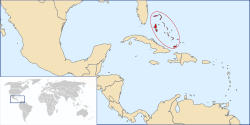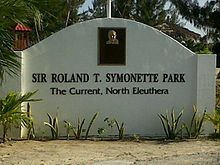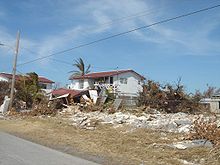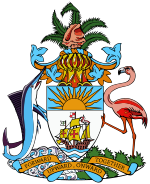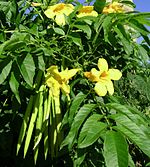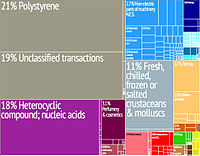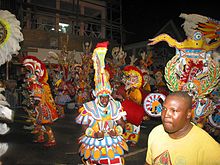
The Bahamas
Background Information
SOS Children, an education charity, organised this selection. Click here for more information on SOS Children.
| Commonwealth of the Bahamas | ||||||
|---|---|---|---|---|---|---|
|
||||||
| Motto: "Forward, Upward, Onward, Together" | ||||||
| Anthem: March On, Bahamaland Royal anthem: God Save the Queen |
||||||
|
|
||||||
| Capital and largest city |
Nassau 25°4′N 77°20′W |
|||||
| Official languages | English | |||||
| Ethnic groups () |
|
|||||
| Demonym | Bahamian | |||||
| Government | Unitary parliamentary constitutional monarchy | |||||
| - | Monarch | Elizabeth II | ||||
| - | Governor-General | Sir Arthur Foulkes | ||||
| - | Prime Minister | Perry Christie | ||||
| Legislature | Parliament | |||||
| - | Upper house | Senate | ||||
| - | Lower house | House of Assembly | ||||
| Independence | ||||||
| - | from the United Kingdom | 10 July 1973 | ||||
| Area | ||||||
| - | Total | 13,878 km2 ( 160th) 5,358 sq mi |
||||
| - | Water (%) | 28% | ||||
| Population | ||||||
| - | 2010 estimate | 353,658 ( 177th) | ||||
| - | 1990 census | 254,685 | ||||
| - | Density | 23.27/km2 ( 181st) 60/sq mi |
||||
| GDP ( PPP) | 2012 estimate | |||||
| - | Total | $11.055 billion | ||||
| - | Per capita | $31,382 | ||||
| GDP (nominal) | 2012 estimate | |||||
| - | Total | $8.043 billion | ||||
| - | Per capita | $22,832 | ||||
| HDI (2011) | high · 53rd |
|||||
| Currency | Bahamian dollar (BSD) (Although USD is Widely Accepted) | |||||
| Time zone | EST ( UTC−5) | |||||
| - | Summer ( DST) | EDT ( UTC−4) | ||||
| Drives on the | left | |||||
| Calling code | +1-242 | |||||
| ISO 3166 code | BS | |||||
| Internet TLD | .bs | |||||
The Bahamas / b ə ˈ h ɑː m ə z /, officially the Commonwealth of the Bahamas, is a country consisting of more than 700 islands, cays, and islets in the Atlantic Ocean; north of Cuba and Hispaniola (the Dominican Republic and Haiti); northwest of the Turks and Caicos Islands; southeast of the U.S. state of Florida and east of the Florida Keys. Its capital is Nassau on the island of New Providence. Geographically, the Bahamas lie near to Cuba, which is part of the Greater Antilles, along with Hispaniola and Jamaica. The designation of "Bahamas" refers to the country and the geographic chain that it shares with the Turks and Caicos Islands. The three West Indies/Caribbean island groupings are: The Bahamas, the Greater Antilles, and the Lesser Antilles. As stated on the mandate/manifesto of The Royal Bahamas Defence Force, The Bahamas territory encompasses 180,000 square miles of ocean space. From the Cay Sal Bank and Cay Lobos (just off of the coast of Cuba) in the west, to San Salvador, The Bahamas is much larger than is recorded in some sources.
Originally inhabited by the Lucayan, a branch of the Arawakan-speaking Taino people, the Bahamas were the site of Columbus' first landfall in the New World in 1492. Although the Spanish never colonized the Bahamas, they shipped the native Lucayans to slavery in Hispaniola. The islands were mostly deserted from 1513 until 1648, when English colonists from Bermuda settled on the island of Eleuthera.
The Bahamas became a British Crown colony in 1718, when the British clamped down on piracy. After the American War of Independence, thousands of American Loyalists, taking their enslaved Africans, moved to the Bahamas, where the Americans set up a plantation economy. After Britain abolished the international slave trade in 1807, the Royal Navy resettled many free Africans liberated from illegal slave ships in the Bahamas during the 19th century. Hundreds of American slaves and Black Seminoles escaped to the islands from Florida, and nearly 500 were freed from American merchant ships in the domestic trade. Slavery in the Bahamas was abolished in 1834. Today the descendants of slaves and free Africans form the majority of the population; issues related to the slavery years are part of society. The Bahamas became an independent Commonwealth realm in 1973, retaining Queen Elizabeth II as monarch.
In terms of Gross Domestic Product per capita, the Bahamas is one of the richest countries in the Americas (following the United States and Canada).
Etymology of name
The name Bahamas is derived from the Spanish baja mar ("shallow water or sea"). In English, the Bahamas is one of only two countries whose official name begins with the word "the", along with the Gambia.
History
Taino people moved into the uninhabited southern Bahamas from Hispaniola and Cuba around the 11th century AD, having migrated there from South America. They came to be known as the Lucayan. An estimated 30,000 Lucayan inhabited the Bahamas at the time of Christopher Columbus' arrival in 1492. Columbus' first landfall in the New World was on an island named San Salvador (known to the Lucayan as Guanahani), which some researchers believe to be present-day San Salvador Island (also known as Watling's Island), situated in the southeastern Bahamas.
An alternative theory holds that Columbus landed to the southeast on Samana Cay, according to calculations made in 1986 by National Geographic writer and editor Joseph Judge, based on Columbus's log. Evidence in support of this remains inconclusive. On the landfall island, Columbus made first contact with the Lucayans and exchanged goods with them.
The Spanish forced much of the Lucayan population to Hispaniola for use as forced labour; together with suffering from exposure to diseases to which they had no immunity, they suffered high fatalities. The population of the Bahamas was decimated. The smallpox that ravaged the Taino Indians after Columbus's arrival wiped out half of the population in what is now the Bahamas.
Historians had long believed that Europeans generally did not begin to colonize the islands until the mid-17th century. However, recent research suggests that there may have been attempts to settle the islands by groups from Spain, France, and Britain, as well as by other Amerindians. In 1648, the Eleutherian Adventurers, led by William Sayle, migrated from Bermuda. These English Puritans established the first permanent European settlement on an island which they named Eleuthera—the name derives from the Greek word for freedom. They later settled New Providence, naming it Sayle's Island after one of their leaders. To survive, the settlers salvaged goods from wrecks.
In 1670 King Charles II granted the islands to the Lords Proprietors of the Carolinas, who rented the islands from the king with rights of trading, tax, appointing governors, and administering the country. In 1684 Spanish corsair Juan de Alcon raided the capital, Charles Town (later renamed Nassau). In 1703 a joint Franco-Spanish expedition briefly occupied the Bahamian capital during the War of the Spanish Succession.
18th-19th centuries
During proprietary rule, the Bahamas became a haven for pirates, including the infamous Blackbeard. To restore orderly government, Britain made the Bahamas a crown colony in 1718 under the royal governorship of Woodes Rogers. After a difficult struggle, he succeeded in suppressing piracy. In 1720, Rogers led local militia to drive off a Spanish attack.
During the American War of Independence, the islands were a target for American naval forces under the command of Commodore Ezekial Hopkins. US Marines occupied the capital of Nassau for a fortnight.
In 1782, following the British defeat at Yorktown, a Spanish fleet appeared off the coast of Nassau, and the city surrendered without a fight. Spain returned possession of the Bahamas to Britain the following year, under the terms of the Treaty of Paris.
After American independence, the British resettled some 7,300 Loyalists and their slaves in the Bahamas from New York, Florida, and the Carolinas, to help compensate them for losses. These Loyalists established plantations on several islands and became a political force in the capital. European Americans were outnumbered by the African-American slaves they brought with them, and ethnic Europeans remained a minority in the territory.
In 1807, the British abolished the slave trade. During the following decades, they resettled thousands of Africans liberated from slave ships by the Royal Navy, which intercepted the trade, in the Bahamian islands. Slavery was finally abolished in the British Empire on 1 August 1834.
In the 1820s, hundreds of American slaves and Black Seminoles escaped from Cape Florida to the Bahamas, settling mostly on northwest Andros Island, where they developed the village of Red Bays. From eyewitness accounts, 300 escaped in a mass flight in 1823, aided by Bahamians in 27 sloops, with others using canoes for the journey. This was commemorated in 2004 by a large sign at Bill Baggs Cape Florida State Park. Some of their descendants continue Black Seminole traditions in basketmaking and grave marking.
The United States' National Park Service, which administers the National Underground Railroad Network to Freedom, is working with the African Bahamanian Museum and Research Centre (ABAC) In Nassau on development to identify Red Bays as a site related to American slaves' search for freedom. The museum has researched and documented the Black Seminoles' escape from southern Florida. It plans to develop interpretive programs at historical sites in Red Bay associated with the period of their settlement in the Bahamas.
In 1818, the Home Office in London had ruled that "any slave brought to the Bahamas from outside the British West Indies would be manumitted." This led to a total of nearly 300 slaves owned by U.S. nationals being freed from 1830 to 1835. The American slave ships Comet and Encomium, used in its domestic coastwise slave trade, had wrecked off Abaco Island in December 1830 and February 1834, respectively. When wreckers took the masters, passengers and slaves into Nassau, customs officers seized the slaves and British colonial officials freed them, over the protests of the Americans. There were 165 slaves on the Comet and 48 on the Encomium. Britain paid an indemnity to the US in those two cases, but only after lengthy delay.
British colonial officials also freed 78 American slaves from the Enterprise, which went into Bermuda in 1835; and 38 from the Hermosa, which wrecked off Abaco island in 1840, after abolition was effective in August 1834. The most notable case was that of the Creole in 1841, the result of a slave revolt whose leaders ordered the American brig to Nassau. It was carrying 135 slaves from Virginia destined for sale in New Orleans. The Bahamian officials freed the 128 slaves who chose to stay in the islands. The Creole case has been described as the "most successful slave revolt in US history".
These incidents, in which a total of 447 slaves belonging to American nationals were freed by 1842, increased tension between the United States and Great Britain, although they had been cooperating in patrols to suppress the international slave trade. Worried about the stability of its domestic slave trade and its value, the US argued that Britain should not treat its domestic ships that came to its colonial ports under duress, as part of the international trade. The US worried that the success of the Creole's slaves in gaining freedom would encourage more slave revolts on merchant ships.
20th century
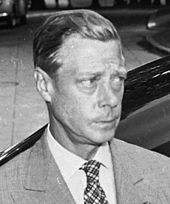
In August 1940, after his abdication, the Duke of Windsor was installed as Governor of the Bahamas, arriving with his wife, the Duchess. Although disheartened at the condition of Government House, they "tried to make the best of a bad situation." He did not enjoy the position, and referred to the islands as "a third-class British colony".
He opened the small local parliament on 29 October 1940. The couple visited the 'Out Islands' that November, on Axel Wenner-Gren's yacht, which caused some controversy. The British Foreign Office strenuously objected to the trip because they had been advised (mistakenly) by United States intelligence that Wenner-Gren was a close friend of the Luftwaffe commander Hermann Göring of Nazi Germany.
The Duke was praised for his efforts to combat poverty on the islands. A 1991 biography by Philip Ziegler described him as contemptuous of the Bahamians and other non-white peoples of the Empire. He was praised for his resolution of civil unrest over low wages in Nassau in June 1942, when there was a "full-scale riot." Ziegler said that the Duke blamed the trouble on "mischief makers – communists" and "men of Central European Jewish descent, who had secured jobs as a pretext for obtaining a deferment of draft".
The Duke resigned the post on 16 March 1945.
Post-World War II
Modern political development began after the Second World War. The first political parties were formed in the 1950s. The British Parliament authorized the islands as internally self-governing in 1964, with Sir Roland Symonette, of the United Bahamian Party, as the first Premier.
The fourth James Bond film, Thunderball, was partly filmed in 1965 in Nassau. The Beatles' film Help! was filmed in part on New Providence Island and Paradise Island the same year.
In 1967, Lynden Pindling ( Sir Lynden from 1983), of the Progressive Liberal Party, became the first black Premier of the colony; in 1968 the title of the position was changed to Prime Minister. In 1973, the Bahamas became fully independent as a Commonwealth realm, retaining membership in the Commonwealth of Nations. Sir Milo Butler was appointed the first Governor-General of the Bahamas (the official representative of Queen Elizabeth II) shortly after independence.
Based on the twin pillars of tourism and offshore finance, the Bahamian economy has prospered since the 1950s. Significant challenges in areas such as education, health care, housing, international narcotics trafficking, and illegal immigration from Haiti continue to be issues.
The College of the Bahamas is the national higher education/tertiary system. Offering baccalaureate, masters and associate degrees, COB has three campuses, and teaching and research centres throughout the Bahamas. The College is in the process of becoming the University of the Bahamas as early as 2012.
Geography and climate
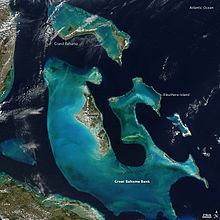
The country lies between latitudes 20° and 28°N, and longitudes 72° and 80°W.
In 1864, the Governor of the Bahamas reported that there were 29 islands, 661 cays, and 2,387 rocks in the colony.
The closest island to the United States is Bimini, which is also known as the gateway to the Bahamas. The island of Abaco is to the east of Grand Bahama. The southeasternmost island is Inagua. The largest island is Andros Island. Other inhabited islands include Eleuthera, Cat Island, Long Island, San Salvador Island, Acklins, Crooked Island, Exuma and Mayaguana. Nassau, capital city of the Bahamas, lies on the island of New Providence.
All the islands are low and flat, with ridges that usually rise no more than 15 to 20 m (49 to 66 ft). The highest point in the country is Mount Alvernia (formerly Como Hill) on Cat Island. It has an altitude of 63 metres (207 ft).
To the southeast, the Turks and Caicos Islands, and three more extensive submarine features called Mouchoir Bank, Silver Bank, and Navidad Bank, are geographically a continuation of the Bahamas, but not part of the Commonwealth of the Bahamas.
Climate
The climate of the Bahamas is subtropical to tropical, and is moderated significantly by the waters of the Gulf Stream, particularly in winter. Conversely, this often proves very dangerous in the summer and autumn, when hurricanes pass near or through the islands. Hurricane Andrew hit the northern islands during the 1992 Atlantic hurricane season, Hurricane Floyd hit most of the islands in 1999 and Hurricane Irene traversed the entire length of the archipelago as a major hurricane in 2011.
While there has never been a freeze reported in the Bahamas, the temperature can fall as low as 2–3 °C (35.6–37.4 °F) during Arctic outbreaks that affect nearby Florida. Snow was reported to have mixed with rain in Freeport in January 1977, when it also snowed in the Miami area. The temperature was about 4.5 °C (40.1 °F) at the time.
| Climate data for Nassau, Bahamas | |||||||||||||
|---|---|---|---|---|---|---|---|---|---|---|---|---|---|
| Month | Jan | Feb | Mar | Apr | May | Jun | Jul | Aug | Sep | Oct | Nov | Dec | Year |
| Average high °C (°F) | 25.4 (77.7) |
25.5 (77.9) |
26.6 (79.9) |
27.9 (82.2) |
29.7 (85.5) |
31.0 (87.8) |
32.0 (89.6) |
32.1 (89.8) |
31.6 (88.9) |
29.9 (85.8) |
27.8 (82) |
26.2 (79.2) |
28.8 (83.8) |
| Daily mean °C (°F) | 21.4 (70.5) |
21.4 (70.5) |
22.3 (72.1) |
23.8 (74.8) |
25.6 (78.1) |
27.2 (81) |
28.0 (82.4) |
28.1 (82.6) |
27.7 (81.9) |
26.2 (79.2) |
24.2 (75.6) |
22.3 (72.1) |
24.8 (76.6) |
| Average low °C (°F) | 17.3 (63.1) |
17.3 (63.1) |
17.9 (64.2) |
19.6 (67.3) |
21.4 (70.5) |
23.3 (73.9) |
24.0 (75.2) |
24.0 (75.2) |
23.7 (74.7) |
22.5 (72.5) |
20.6 (69.1) |
18.3 (64.9) |
20.8 (69.4) |
| Precipitation mm (inches) | 39.4 (1.551) |
49.5 (1.949) |
54.4 (2.142) |
69.3 (2.728) |
105.9 (4.169) |
218.2 (8.591) |
160.8 (6.331) |
235.7 (9.28) |
164.1 (6.461) |
161.8 (6.37) |
80.5 (3.169) |
49.8 (1.961) |
1,389.4 (54.701) |
| Avg. precipitation days | 8 | 6 | 7 | 8 | 10 | 15 | 17 | 19 | 17 | 15 | 10 | 8 | 140 |
| Mean monthly sunshine hours | 220.1 | 220.4 | 257.3 | 276.0 | 269.7 | 231.0 | 272.8 | 266.6 | 213.0 | 223.2 | 222.0 | 213.9 | 2,886 |
| Source: World Meteorological Organization (UN), Hong Kong Observatory for data of sunshine hours | |||||||||||||
| Jan | Feb | Mar | Apr | May | Jun | Jul | Aug | Sep | Oct | Nov | Dec |
|---|---|---|---|---|---|---|---|---|---|---|---|
| 73 °F 23 °C |
73 °F 23 °C |
75 °F 24 °C |
79 °F 26 °C |
81 °F 27 °C |
82 °F 28 °C |
82 °F 28 °C |
82 °F 28 °C |
82 °F 28 °C |
81 °F 27 °C |
79 °F 26 °C |
75 °F 24 °C |
Government and politics
The Bahamas is a parliamentary constitutional monarchy headed by Queen Elizabeth II in her role as Queen of the Bahamas. Political and legal traditions closely follow those of the United Kingdom and the Westminster system. The two main parties are the Free National Movement and the Progressive Liberal Party.
Tourism generates about half of all jobs, but the number of visitors has dropped significantly since the beginning of the global economic downturn during the last quarter of 2008. Banking and international financial services also have contracted.
The Bahamas is a member of the Commonwealth of Nations as a Commonwealth realm, with Her Majesty Queen Elizabeth II as head of state (represented by a Governor-General).
Legislative power is vested in a bicameral parliament, which consists of a 38-member House of Assembly (the lower house), with members elected from single-member districts, and a 16-member Senate, with members appointed by the Governor-General, including nine on the advice of the Prime Minister, four on the advice of the Leader of Her Majesty's Loyal Opposition, and three on the advice of the Prime Minister after consultation with the Leader of the Opposition. The House of Assembly carries out all major legislative functions. As under the Westminster system, the Prime Minister may dissolve Parliament and call a General Election at any time within a five-year term.
The Prime Minister is the head of government and is the leader of the party with the most seats in the House of Assembly. Executive power is exercised by the Cabinet, selected by the Prime Minister and drawn from his supporters in the House of Assembly. The current Governor-General is His Excellency Sir Arthur Foulkes, G.C.M.G., and the current Prime Minister is The Rt. Hon. Perry Christie, P.C., M.P..
The Bahamas has a largely two-party system dominated by the centre-left Progressive Liberal Party and the centre-right Free National Movement. A handful of splinter parties have been unable to win election to parliament. These parties have included the Bahamas Democratic Movement, the Coalition for Democratic Reform, Bahamian Nationalist Party and the Democratic National Alliance.
Constitutional safeguards include freedom of speech, press, worship, movement, and association. Although the Bahamas is not geographically located in the Caribbean, it is a member of the Caribbean Community. The judiciary is independent of the executive and the legislature. Jurisprudence is based on English law.
Administrative divisions
The districts of the Bahamas provide a system of local government everywhere except New Providence, whose affairs are handled directly by the central government. In 1996, the Bahamian Parliament passed "The Local Government Act" to facilitate the establishment of Family Island Administrators, Local Government Districts, Local District Councillors, and Local Town Committees for the various island communities. The overall goal of this act is to allow the various elected leaders to govern and oversee the affairs of their respective districts without the interference of Central Government. In total, there are 38 districts, with elections being held every five years. There are also one hundred and ten Councillors and two hundred and eighty-one Town Committee members to correspond with the various districts.
Each Councillor or Town Committee member is responsible for the proper use of public funds for the maintenance and development of their constituency.
The districts other than New Providence are:
|
|
Military
The Bahamas does not have an army or an air force. Its military is composed of the Royal Bahamas Defence Force (the R.B.D.F.), the navy of The Bahamas. Under The Defence Act, the R.B.D.F. has been mandated, in the name of The Queen, to defend The Bahamas, protect its territorial integrity, patrol its waters, provide assistance and relief in times of disaster, maintain order in conjunction with the law enforcement agencies of The Bahamas, and carry out any such duties as determined by the National Security Council. The Defence Force is also a member of Caricom's Regional Security Task Force.
The R.B.D.F. officially came into existence on 31 March 1980. Their duties include defending The Bahamas, stopping drug smuggling, illegal immigration, poaching, and providing assistance to mariners whenever and wherever they can. The Defence Force has a fleet of 26 coastal and inshore patrol craft along with 6 aircraft and over 1500 personnel including 65 officers and 74 women.
National flag
The colours embodied in the design of the Bahamian flag symbolise the image and aspirations of the people of The Bahamas; the design reflects aspects of the natural environment (sun, sand, and sea) and the economic and social development. The flag is a black equilateral triangle against the mast, superimposed on a horizontal background made up of two colours on three equal stripes of aquamarine, gold and aquamarine.
The symbolism of the flag is as follows: Black, a strong colour, represents the vigour and force of a united people, the triangle pointing towards the body of the flag represents the enterprise and determination of The Bahamian people to develop and possess the rich resources of sun and sea symbolized by gold and aquamarine respectively. In reference to the representation of the people with the colour black, some white Bahamians have joked that they are represented in the thread which "holds it all together."
There are rules on how to use the flag for certain events. For a funeral the National Flag should be draped over the coffin covering the top completely but not covering the bearers. The black triangle on the flag should be placed over the head of the deceased in the coffin. The flag will remain on the coffin throughout the whole service and removed right before lowered into the grave. Upon removal of the flag it should be folded with dignity and put away. The black triangle should never be displayed pointing upwards or from the viewer's right. This would be a sign of distress.
Coat of arms
The Coat of Arms of the Bahamas contains a shield with the national symbols as its focal point. The shield is supported by a marlin and a flamingo, which are the national animals of the Bahamas. The flamingo is located on the land, and the marlin on the sea, indicating the geography of the islands.
On top of the shield is a conch shell, which represents the varied marine life of the island chain. The conch shell rests on a helmet. Below this is the actual shield, the main symbol of which is a ship representing the Santa María of Christopher Columbus, shown sailing beneath the sun. Along the bottom, below the shield appears a banner upon which is scripted the national motto:
"Forward, Upward, Onward Together."
National flower
The yellow elder was chosen as the national flower of the Bahamas because it is native to the Bahama Islands, and it blooms throughout the year.
Selection of the yellow elder over many other flowers was made through the combined popular vote of members of all four of New Providence's garden clubs of the 1970s – the Nassau Garden Club, the Carver Garden Club, the International Garden Club, and the Y.W.C.A. Garden Club.
They reasoned that other flowers grown there – such as the bougainvillea, hibiscus, and poinciana – had already been chosen as the national flowers of other countries. The yellow elder, on the other hand, was unclaimed by other countries (although it is now also the national flower of the United States Virgin Islands).
Economy
One of the most prosperous countries in the West Indies, The Bahamas relies on tourism to generate most of its economic activity. Tourism as an industry not only accounts for over 60 percent of the Bahamian GDP, but provides jobs for more than half the country's workforce. After tourism, the next most important economic sector is financial services, accounting for some 15 percent of GDP.
The government has adopted incentives to encourage foreign financial business, and further banking and finance reforms are in progress. The government plans to merge the regulatory functions of key financial institutions, including the Central Bank of The Bahamas (CBB) and the Securities and Exchange Commission. The Central Bank administers restrictions and controls on capital and money market instruments. The Bahamas International Securities Exchange currently consists of 19 listed public companies. Reflecting the relative soundness of the banking system (mostly populated by Canadian banks), the impact of the global financial crisis on the financial sector has been limited.
The economy has a very competitive tax regime. The government derives its revenue from import tariffs, license fees, property and stamp taxes, but there is no income tax, corporate tax, capital gains tax, value-added tax (VAT), or wealth tax. Payroll taxes fund social insurance benefits and amount to 3.9% paid by the employee and 5.9% paid by the employer. In 2010, overall tax revenue as a percentage of GDP was 17.2%. Authorities are trying to increase tax compliance and collection in the wake of the global crisis. Inflation has been moderate, averaging 3.7 percent between 2006 and 2008.
By the terms of GDP per capita, the Bahamas is one of the richest countries in the Americas.
Ethnic groups
Afro-Bahamians
Afro-Bahamians are Bahamian nationals whose primary ancestry lies in West Africa. The first Africans to arrive to The Bahamas came from Bermuda with the Eleutheran Adventurers as freed slaves looking for a new life. Currently, Afro-Bahamians are the largest ethnic group in The Bahamas, accounting for some 85% of the country's population. The Haitian community numbers about 80,000.
Europeans
According to the 2010 Census of Bahamas, there are a total of 16,598 Whites living there. European Bahamians, or Bahamians of European descent, numbering about 38,000, are mainly the descendants of the English Puritans and American Loyalists who arrived in 1649 and 1783 respectively. They form the largest minority group in The Bahamas, making up some 12% of the population. Many Southern Loyalists went to Abaco, which is about 50% white.
A small portion of the European Bahamian population is descended from Greek labourers who came to help develop the sponging industry in the 1900s. Although making up less than 1% of the nation's population, they have been able to preserve their distinct Greek Bahamian culture.
One of the features of the Bahamian genealogy is that most families have branches, and even immediate family members, spanning the entire spectrum between ‘ light’, 'brown' and ‘unequivocally dark.’
Anglophile former colonies of the United Kingdom do not use the prefix "Afro" to describe themselves. In all areas, the formal term West Indian is used, despite ancestral origins. The terms Afro and Euro are thrust upon them by the outside world, to categorise the ethnic groups. Attitudes towards race are different in the West Indies, and plays no major role as it would in the United States.
In The Bahamas, the term Bahamian, is the only term in use, as the term West Indian is not readily acknowledged.
Additionally, many Bahamians are of shared descent, including Rick Fox, Persia White, and Lenny Kravitz.
Demographics
The Bahamas have a total population of 347,176, of which 25.9% are under 14, 67.2% 15 through 64, and 6.9% over 65. It has a population growth rate of 0.925% (2010 est.), with a birth rate of 17.81/1000 population, death rate of 9.35/1000, and net migration rate of -2.13 migrant(s)/1,000 population.
The infant mortality rate is 23.21 deaths/1,000 live births. Residents have a life expectancy at birth of 69.87 years: 73.49 years for females, 66.32 years for males. The total fertility rate is 2.0 children born/woman (2010 est.)
The ethnic makeup of the country is African 85%, European 12%, Asian and Latin Americans 3%. In terms of religion, Baptists represent 35.4% of the population, Anglican 15.1%, Roman Catholic 13.5%, Pentecostal 8.1%, Church of God 4.8%, Methodist 4.2%, other Christian 15.2%, other Protestant 12%, none or unknown 3%, other 2% The 'other' category includes Jews, Muslims, Baha'is, Hindus, Rastafarians, and practitioners of Obeah.
The official language of the Bahamas is English; many residents speak the Bahamian Dialect. 98.2% of the adult population is literate, according to 1995 estimates.
Largest cities
Culture
In the less developed outer islands, handicrafts include basketry made from palm fronds. This material, commonly called "straw", is plaited into hats and bags that are popular tourist items. Another use is for so-called "Voodoo dolls," even though such dolls are the result of the American imagination and not based on historic fact.
A form of folk magic ( obeah) is practiced by some Bahamians but, mostly the Haitian-Bahamian community, mainly in the Family Islands (out-islands) of The Bahamas. The practice of obeah is, however, illegal in the Bahamas and punishable by law. Junkanoo is a traditional Bahamian street parade of music, dance, and art held in Nassau (and a few other settlements) every Boxing Day, New Year's Day. Junkanoo is also used to celebrate other holidays and events such as Emancipation Day.
Regattas are important social events in many family island settlements. They usually feature one or more days of sailing by old-fashioned work boats, as well as an onshore festival.
Some settlements have festivals associated with the traditional crop or food of that area, such as the "Pineapple Fest" in Gregory Town, Eleuthera or the "Crab Fest" on Andros. Other significant traditions include story telling.
Bahamians have created a rich literature of poetry, short stories, plays, and short fictional works. Common themes in these works are (1) an awareness of change, (2) a striving for sophistication, (3) a search for identity, (4) nostalgia for the old ways, and (5) an appreciation of beauty. Some contributing writers are Susan Wallace, Percival Miller, Robert Johnson, Raymond Brown, O.M. Smith, William Johnson, Eddie Minnis, Winston Saunders, and many others.
Bahamas culture is rich with beliefs, traditions, folklore and legend. The most well-known folklore and legends in Bahamas includes Lusca in Andros Bahamas, Pretty Molly on Exuma Bahamas, The Chickcharnies of Andro Bahamas, and the Lost City of Atlantis on Bimini Bahamas.


